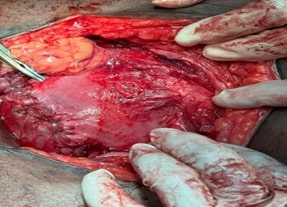A Case Report on Scar Site Endometriosis

Abstract:
The development of functioning endometrial tissue in the abdominal wall after a cesarean birth is an uncommon case phenomenon known as scar endometriosis. Aside from the pelvis, endometriosis most often manifests in the bladder, gastrointestinal system, and, most notably, after obstetric surgical procedures. Here we present a case of caesarean scar endometriosis in a pregnant woman of 30 years of age. The patient has a history of type 1 diabetes mellitus, is now taking insulin and oral hypoglycaemic medications, and is being treated for hypothyroidism. She said that the region around her prior cesarean scar was swollen and painful periodically. USG showed ill defined heterogeneous hypo-echoic subcutaneous mass lesion approximately measuring 3*2*3cms over the right lateral one third of the caesarean scar site.MRI report showing a well-defined hypointense lesion in the anterior abdominal wall in the previous caesarean scar site suggestive of scar endometriosis. A total of three masses were removed, and scar endometriosis was verified by histology.
References:
[1]. Choudhury,
H., Pandey, M., Hua, C. K., Mun, C. S., Jing, J. K., Kong, L., Ern, L. Y.,
Ashraf, N. A., Kit, S. W., Yee, T. S., Pichika, M. R., Gorain, B., &
Kesharwani, P., 2018, An Update on Natural Compounds in the Remedy of Diabetes
Mellitus: A Systematic Review. Journal of Traditional and Complementary
Medicine, 8(3): 361–376. https://doi.org/10.1016/J.Jtcme.2017.08.012(2018)
[2]. Kharroubi,
A. T., 2015, Diabetes Mellitus: The Epidemic of the Century. World Journal of
Diabetes, 6(6): 850. https://doi.org/10.4239/Wjd.V6.I6.850
[3]. International
Diabetes Federation, 2021, IDF Diabetes Atlas, 10th Edition. https://idf.org/About-Diabetes/Diabetes-Facts-Figures/(2021)
[4]. Missoun,
F., 2018, Antidiabetic Bioactive Compounds from Plants. Medical Technologies
Journal, 2(2): 199–214. https://doi.org/10.26415/2572-004x-Vol2iss2p199-214(2018)
[5]. Caro-Ordieres,
T., Marín-Royo, G., Opazo-Ríos, L., Jiménez-Castilla, L., Moreno, J. A.,
Gómez-Guerrero, C., & Egido, J., 2020, The Coming Age of Flavonoids in the
Treatment of Diabetic Complications. Journal of Clinical Medicine, 9(2):
346. https://doi.org/10.3390/Jcm9020346(2020)
[6]. AL-Ishaq,
Abotaleb, Kubatka, Kajo, & Büsselberg, 2019, Flavonoids and their
Anti-Diabetic Effects: Cellular Mechanisms and Effects to Improve Blood Sugar
Levels. Biomolecules, 9(9): 430. https://doi.org/10.3390/Biom9090430(2019)
[7]. Venugopala,
K. N., Chaudhary, J., Sharma, V., Jain, A., Kumar, M., Sharma, D., & Et
Al., 2022, Exploring the Potential of Flavonoids as Efflorescing Antidiabetic:
An Updated SAR and Mechanistic Based Approach. Pharmacognosy Magazine, 18(80):
791-807. https://www.Phcog.Com/Text.Asp?2022/18/80/791/357236(2022)
[8]. Bai,
L., Li, X., He, L., Zheng, Y., Lu, H., Li, J., Zhong, L., Tong, R., Jiang, Z.,
Shi, J., & Li, J., 2019, Antidiabetic Potential of Flavonoids from
Traditional Chinese Medicine: A Review. The American Journal of Chinese
Medicine, 47(05): 933–957. https://doi.org/10.1142/S0192415x19500496(2019)
[9]. Sohretoglu,
D., & Sari, S., 2019, Flavonoids as Alpha-Glucosidase Inhibitors:
Mechanistic Approaches Merged with Enzyme Kinetics and Molecular Modelling.
Phytochemistry Reviews, 19(5): 1081–1092. https://doi.org/10.1007/S11101-019-09610-6(2019)
[10]. Ke, R.
Q., Wang, Y., Hong, S. H., & Xiao, L. X., 2023, Anti-Diabetic Effect of
Quercetin in Type 2 Diabetes Mellitus by Regulating the MicroRNA-92b-3p/EGR1
Axis. Journal of Physiology and Pharmacology: An Official Journal of the
Polish Physiological Society, 74(2). https://doi.org/10.26402/Jpp.2023.2.03(2023)
[11]. Ansari,
P., Choudhury, S. T., Seidel, V., Rahman, A. B., Aziz, Md. A., Richi, A. E.,
Rahman, A., Jafrin, U. H., Hannan, J. M. A., & Abdel-Wahab, Y. H. A., 2022,
Therapeutic Potential of Quercetin in the Management of Type-2 Diabetes
Mellitus. Life, 12(8): 1146. https://doi.org/10.3390/Life12081146(2022)
[12]. Yang,
Y., Chen, Z., Zhao, X., Xie, H., Du, L., Gao, H., & Xie, C., 2022,
Mechanisms of Kaempferol in the Treatment of Diabetes: A Comprehensive and
Latest Review. Frontiers in Endocrinology, 13. https://doi.org/10.3389/Fendo.2022.990299(2022)
[13]. Kumari,
G., Nigam, V. K., & Pandey, D. M., 2022, The Molecular Docking and
Molecular Dynamics Study of Flavonol Synthase and Flavonoid 3’-Monooxygenase
Enzymes Involved for the Enrichment of Kaempferol. Journal of Biomolecular
Structure and Dynamics, 41(6): 2478–2491. https://doi.org/10.1080/07391102.2022.2033324(2022)
[14]. Qaddoori,
M. H., & Al-Shmgani, H. S., 2023, Galangin-Loaded Gold Nanoparticles:
Molecular Mechanisms of Antiangiogenesis Properties in Breast Cancer. International
Journal of Breast Cancer, 2023: 1–14. https://doi.org/10.1155/2023/3251211(2023)
[15]. Al
Duhaidahawi, D., Hasan, S. A., & Al Zubaidy, H. F. S., 2021, Flavonoids in the
Treatment of Diabetes: Clinical Outcomes and Mechanism to Ameliorate Blood
Glucose Levels. Current Diabetes Reviews, 17(6). https://doi.org/10.2174/1573399817666201207200346(2021)
[16]. Mathew,
M. G., Jeevanandan, G., Vishwanathaiah, S., Hamzi, K. A., Depsh, M. A. N.,
& Maganur, P. C., 2022, Parental and Child Outlook on the Impact of ECC on
Oral Health-Related Quality of Life: A Prospective Interventional Study. The
Journal of Contemporary Dental Practice, 23(9), 877–882. https://doi.org/10.5005/Jp-Journals-10024-3397(2022)
[17]. Jayaraman,
S., Natarajan, S. R., Veeraraghavan, V. P., 2023, Unveiling the Anti-Cancer
Mechanisms of Calotropin: Insights into Cell Growth Inhibition, Cell Cycle
Arrest, and Metabolic Regulation in Human Oral Squamous Carcinoma Cells
(HSC-3). Journal of Oral Biology and Craniofacial Research, 13(6),
704–713. https://doi.org/10.1016/J.Jobcr.2023.09.002(2023)
[18]. Liao,
Y., Hu, X., Pan, J., & Zhang, G., 2022, Inhibitory Mechanism of Baicalein on
Acetylcholinesterase: Inhibitory Interaction, Conformational Change, and
Computational Simulation. Foods, 11(2): 168. https://doi.org/10.3390/Foods11020168(2022)
[19]. Chan,
S.-H., Hung, C.-H., Shih, J.-Y., Chu, P.-M., Cheng, Y.-H., Tsai, Y.-J., Lin,
H.-C., & Tsai, K.-L., 2016, Baicalein is an Available Anti-Atherosclerotic
Compound Through Modulation of Nitric Oxide-Related Mechanism Under OxLDL
Exposure. Oncotarget, 7(28): 42881–42891. https://doi.org/10.18632/Oncotarget.10263 (2016)
[20]. Cazarolli, L., Zanatta, L., Alberton, E., Bonorino Figueiredo, M. S., Folador, P., Damazio, R., Pizzolatti, M., & Barreto Silva, F. R., 2008, Flavonoids: Prospective Drug Candidates. Mini-Reviews in Medicinal Chemistry, 8(13): 1429–1440. https://doi.org/10.2174/138955708786369564(2008)

